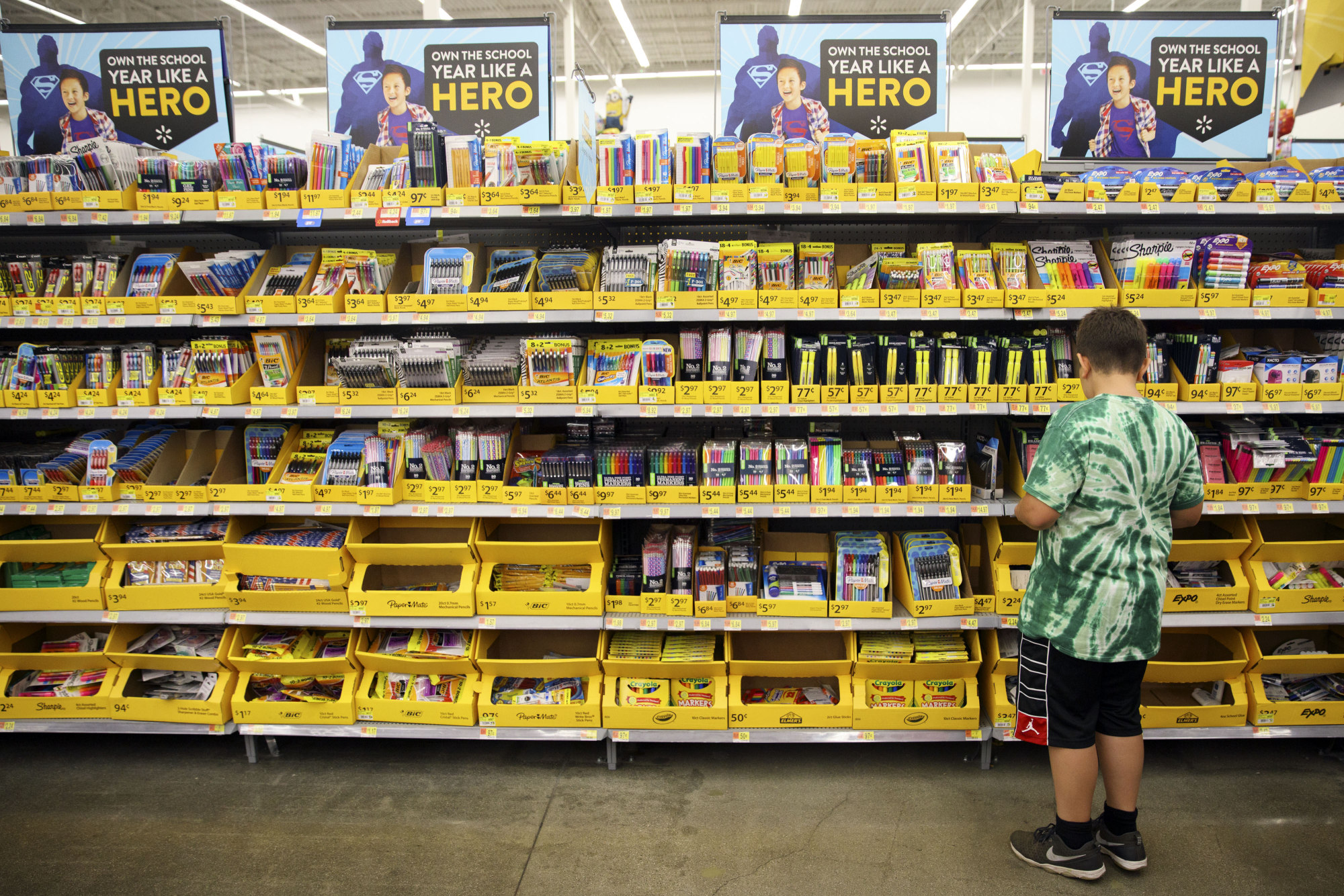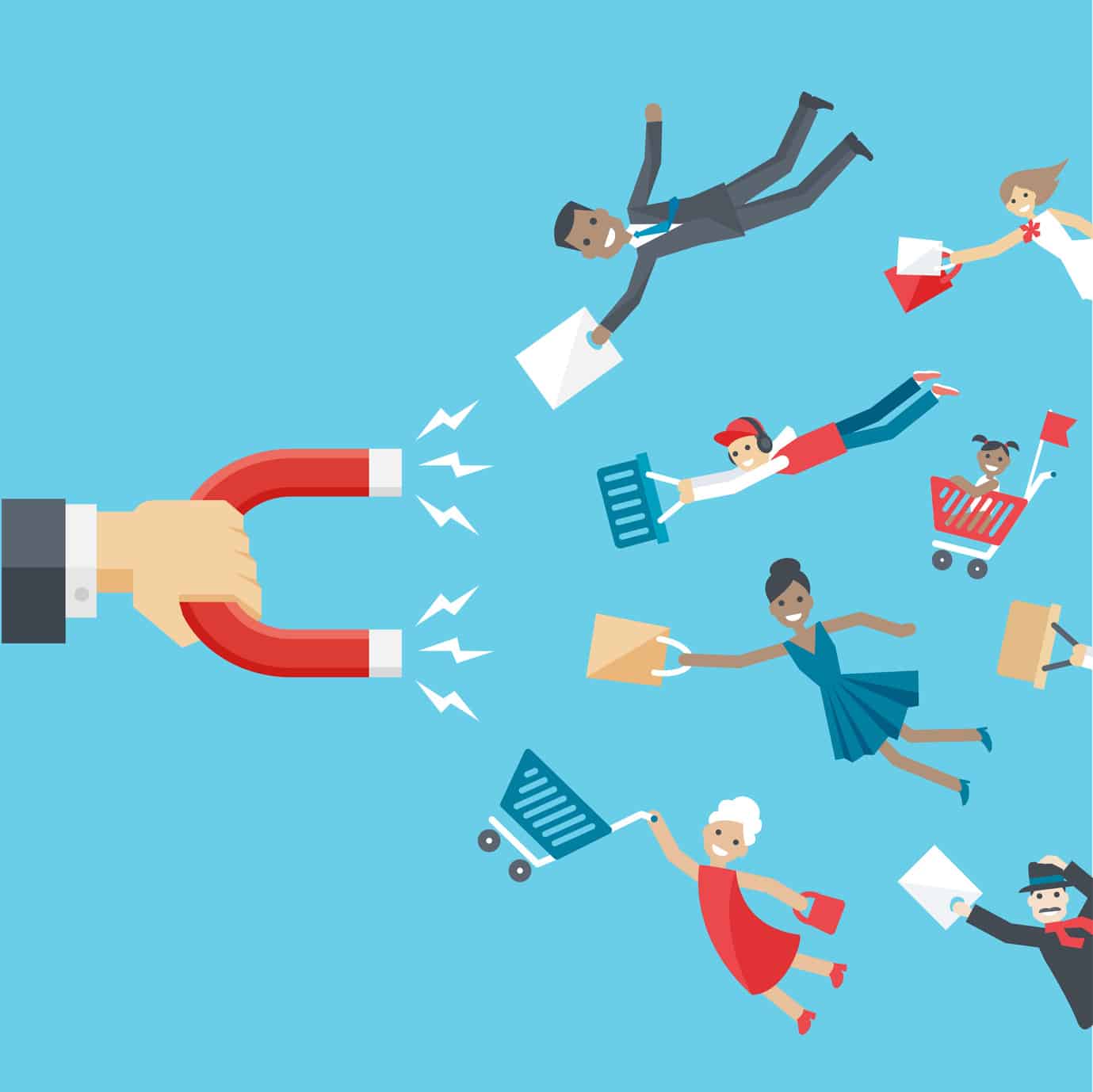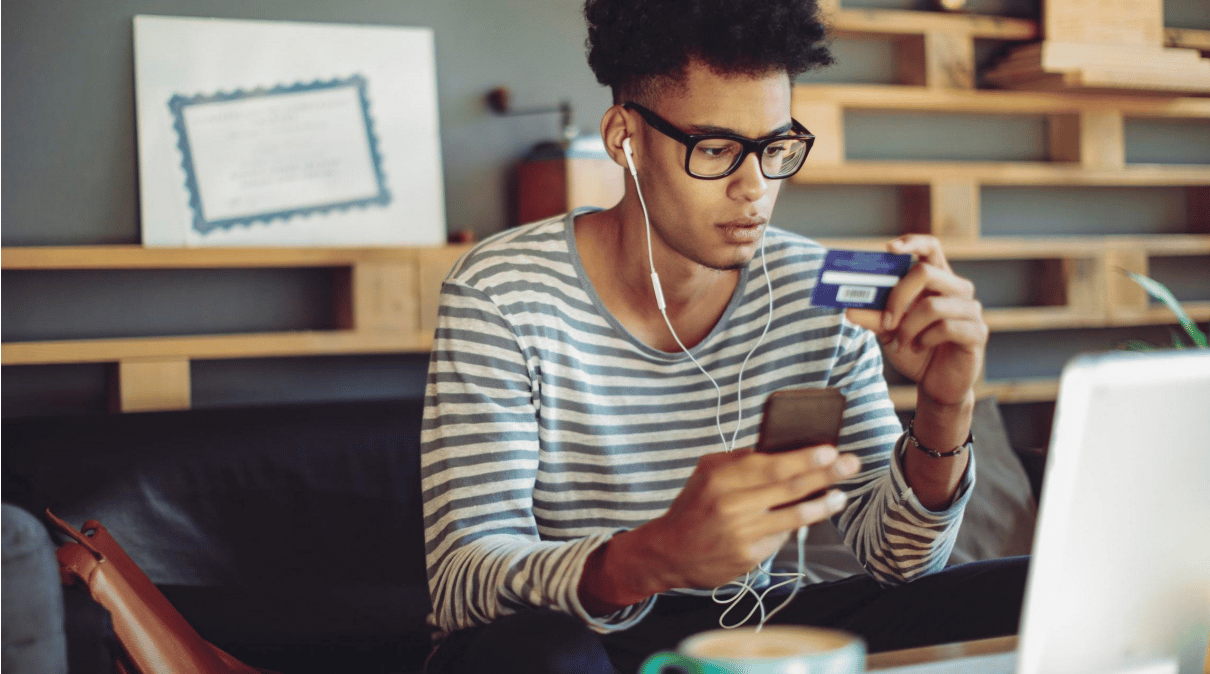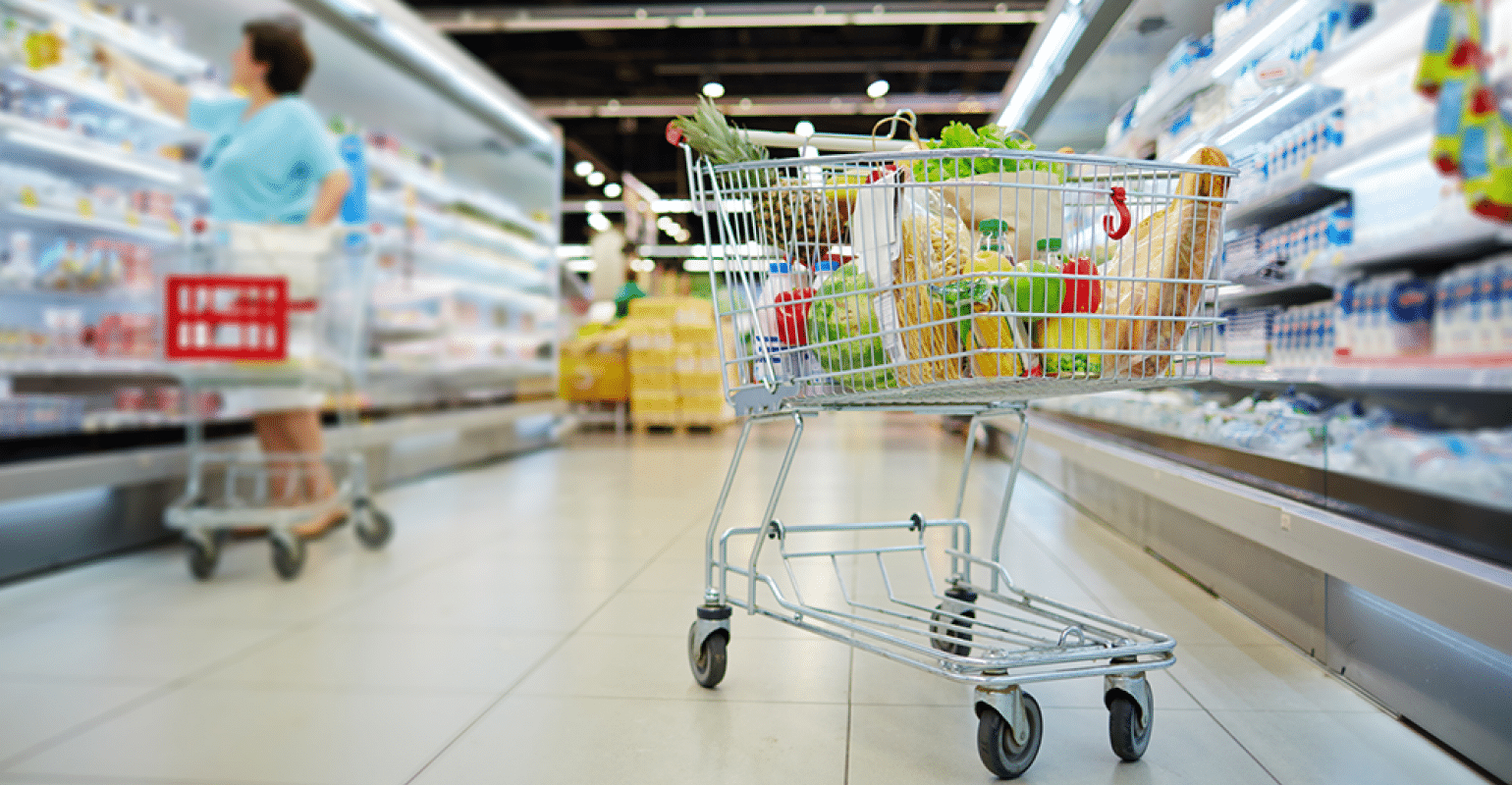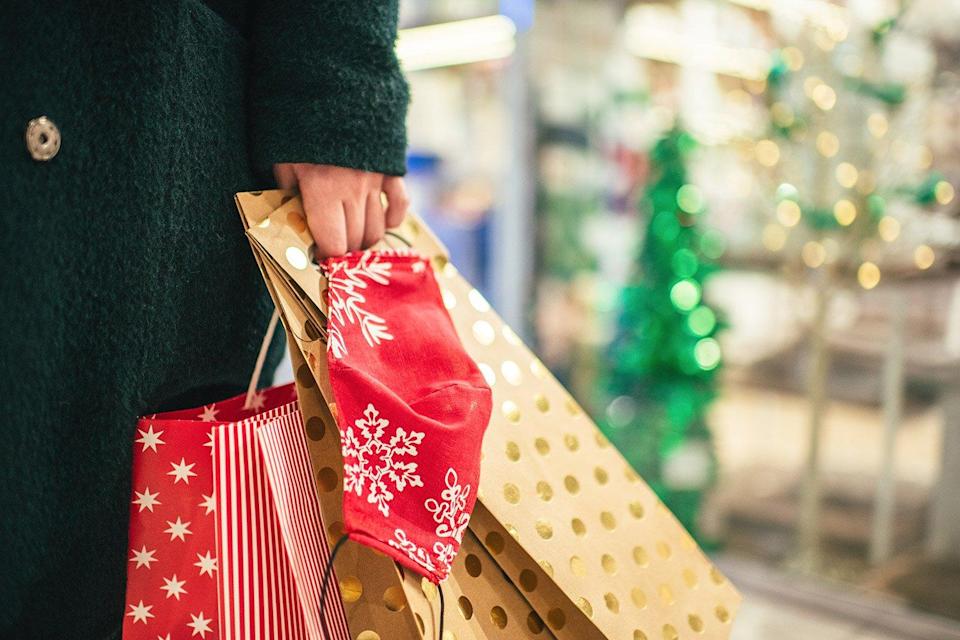Join us as we dive into the evolving landscape of consumer loyalty in the CPG industry. With Instacart, in-store pick-up, and other grocery innovations shaking up the market, the traditional concept of brand loyalty is being redefined. After surveying over 10,000 consumers, the number one reason why consumers shift in loyalty for CPG brands is due to product not being on the shelf when they want it! In this session, we’ll dive into consumer shopping expectations and offer innovative solutions. Trax’s Signal-Based Merchandising is a new way to merchandise, providing brands with immediate access to insights for addressing out-of-stocks, phantom inventory, pricing disparities and more. It’s time to stay ahead during this pivotal point of disruption.
Category: CPG
79 Percent of Consumers Expect Inflation to Impact their Back-To-School Shopping
Shopkick survey finds that 77 percent of consumers plan to take advantage of the sales tax-free weekend(s) in their state to save money on back-to-school shopping
With US inflation being the highest it has been in four decades, consumers are looking for ways to cut costs — especially when it comes to back-to-school shopping. As American families head in-store to stock up on school supplies, 75 percent of consumers say their top priority is getting the best price, with 77 percent planning to utilize sales tax-free periods in their state to shop without the additional financial burden of a sales tax.
Shopkick, a leading shopping rewards app, surveyed more than 12,500 consumers to uncover how they are planning to shop this back-to-school season.
Key Insights Include:
- Tightened Budgets: Nearly half (40 percent) of consumers expect to spend less on back-to-school items this year than they did last year with the largest segment of shoppers (39 percent) planning to spend under $100. The majority (61 percent) say they have tightened their budgets because of rising inflation. For those planning to spend more, 28 percent of shoppers say it is because they need to purchase all new school supplies whereas they did not last year. Other consumers say it is because last school year was entirely virtual (26 percent), they did not back-to-school shop last year (21 percent), their budget was tightened due to the pandemic but they are back to regular spending habits (19 percent), they need to make smaller purchases they did not have to last year (17 percent), and they need to make big-ticket purchases they did not need to last year (15 percent).
- Inflation Impact: Of the consumers that expect inflation to impact their back-to-school shopping, the majority (70 percent) plan to spend less on non-essential purchases as well as hunt for deals and compare prices more than they typically would. Other shoppers are using coupons and rewards apps more (64 percent), making fewer shopping trips (47 percent), and using buy now, pay later more than usual (9 percent).
- School Supply Savings Tips: The majority of consumers are utilizing different tips and hacks to help save money this back-to-school season, such as using coupons and rewards apps (74 percent), watching prices to wait for sales, deals and discounts (67 percent), shopping at thrift stores for discounted items (33 percent), upcycling old items and materials (24 percent), buying used or hand-me-down school uniforms (11 percent), buying one set of books to share (7 percent), and renting sports, band and club equipment rather than buying it (4 percent).
- Safety Precautions Remain: Consumers are still planning on purchasing essential items to protect against COVID-19 when back-to-school shopping this year with the majority of shoppers planning to purchase hand sanitizer (64 percent), cleaning wipes (59 percent), paper products (45 percent), masks (38 percent), gloves (17 percent), and disposable cutlery for lunches (16 percent).
- Shoppers Head In-Store: Similar to last year, nearly all (91 percent) of this year’s back-to-school shoppers plan to make their purchases in physical retailers, a noticeable increase compared to 2020, when 66 percent said they would shop in-store.
- Wavering Loyalty: Although 55 percent of shoppers are moderately loyal to brands they buy their back-to-school supplies from, 89 percent would be willing to switch to a new brand for their back-to-school needs if they could earn rewards for doing so.
- Bring on Big Box: Of the 91 percent of consumers who plan to do their back-to-school shopping in-store, the majority (89 percent) plan to do so at Big Box retailers. Other consumers plan to shop at Dollar stores (46 percent), off-price retailers (38 percent) and office supply stores (30 percent). Of the 51 percent of consumers who plan to do their back-to-school shopping online, the majority plan to shop on Amazon (85 percent). Other back-to-school online shoppers plan to use Big Box retailer sites (64 percent), office supply sites (21 percent), and apparel and accessory sites (20 percent).
- Making Mobile Purchases: Mobile devices will be of great use to consumers this back-to-school season, with 83 percent of Americans saying they will use their mobile devices while shopping, for everything from comparing prices to making mobile purchases.
Sticky CX: How to Design Experiences that Keep Customers Coming Back
Creating ‘sticky’ customer experience (CX) is about more than just brand loyalty – it’s about staying relevant and interesting to customers wherever they are in a buying cycle. In fact, argues Nick Pearse of agency Vertical Leap, the secret to sticky CX is engaging customers when buying intent is lowest: right after purchase.
Customer experience (CX) design acknowledges the importance of interactions between brands and consumers at every stage of the consumer journey. This starts as soon as someone discovers a new brand and culminates with a purchase, but continues long after purchase. Top brands develop sticky customer experiences that compel people to keep buying from them after the initial purchase. This is critical in the age of consumer power.
Why is a sticky CX important?
Sticky CX design aims to convert new customers and maximize the percentage of them who keep buying from you. It’s more expensive to win new customers than convert previous buyers, especially if you provide a quality customer experience. Returning customers spend 67% more on brands they trust.
Customer stickiness is an important measure of the quality of experience you provide across the entire customer cycle (lead capture, lead nurturing, the buying process, product/service quality, the post-purchase experience).
The buying process and post-purchase experiences are particularly important, as we’ll see when we look at the top reasons behind repeat purchases.
By optimizing the entire customer experience, a sticky CX elevates KPIs that drive revenue and growth, including repeat purchases; customer retention, value, lifespan, loyalty and satisfaction; purchase value; positive reviews; brand engagement, citations and reputation – and all the way down to revenue, ROI and growth.
To create a sticky CX, you have to optimize the whole customer experience – before, during and after the purchase – to maintain engagement and motivate customers to remain active in the buying cycle.
Customer stickiness vs customer loyalty
Customer loyalty focuses on the emotional connection between brands and consumers; stickiness places more emphasis on repeat transactional value.
Customers can remain loyal to your brand as long as they don’t buy similar products or services from rival companies, which doesn’t mean they’re necessarily buying from you as often as they could.
Designing a sticky customer experience doesn’t only strive to maximize customer loyalty but also customer value by increasing the frequency of purchases and/or the value of purchases throughout the relationship.
What makes customers buy again?
According to Bread’s 2020 Consumer Shopping Survey, convenience is the top reason shoppers make repeat purchases from an online retailer.
While it’s important to address consumer priorities, CX design encompasses more than the deciding factors consumers face on product pages. Companies need to craft experiences that maximize customer satisfaction, keep them engaged when they’re not buying, and time motivational messages with precision to inspire new purchase impulses.
Frictionless buying (optimizing the buying process for repeat purchases) is important, but you should also keep an eye on other metrics:
• Time-to-value: Deliver value as quickly as possible after each new purchase.
• Maximize value: Help customers get the most out of their most recent purchase.
• Lifecycle data: Analyze purchase habits to learn when different customers types are ready and most likely to buy again – and what they’ll buy.
You can also motivate engagement, giving customers a reason to keep visiting your website with temporary deals and rapid product rollouts. It helps to identify VIPs and give repeat customers special status and rewards for repeat purchases. Instant responses are useful here, giving priority support to your best customers.
You can use these efforts to build a community, using customers to drive engagement. It helps to build an emotional connection between customers and the brand. Showcasing loyal customers in social campaigns and putting the spotlight on them is good too.
Then, of course, there are the usual tactics for customer retention, such as cross-selling and upselling. Retention may be a key part of building a sticky CX but you can’t rely on transactional interactions alone – you also have to optimize the gaps between purchases and nurture emotional motivations.
The secret to sticky CX is keeping customers engaged after their most recent purchase, while intent is at its lowest, especially across channels that you can use to build motivation over time.
This article was written by Nick Pearse from The Drum and was legally licensed through the Industry Dive Content Marketplace. Please direct all licensing questions to legal@industrydive.com.
Marrying Consumer Expectations With Values
How to align brand values to today’s consumer expectations was at the center of topics covered at the recent 2022 CEO Summit hosted in New York City by the Jay H. Baker Retailing Center at the Wharton School of the University of Pennsylvania and the Retail Leaders Circle. The conference’s theme, “Values + Purpose: Leading the Neo-Renaissance,” offered a fascinating look into how some of the nation’s top brand and retail leaders such as Pfizer’s Sally Sussman and Revlon’s Debra Perelman among others are innovating today in order to remain relevant tomorrow.
Here are my top takeaways:
Gen Z’s influence continues to impact everyone; Sustainability is sticky
Throughout the CEO Conference, every speaker touched upon issues that are being driven by Gen Z, from community building to saving the planet. First Insight’s recent survey in partnership with Wharton reveals that Gen Z is using its collective voice to influence all generations, and that is especially true when it comes to sustainability. Retailers, brands, and manufacturers need to pay close attention because by 2031, Gen Z’s income will surpass that of millennials. Gen Z values sustainability over brand name, will pay more for sustainable products, and is convincing their Gen X parents to do the same.
As retailer and brand CEOs grapple with making sure that their brand continues to resonate with younger consumers, they need to actively listen to these consumers to understand how to improve their efforts on sustainability.
Leveraging the data collected from these conversations is one way that companies can evolve to achieve more purpose driven initiatives, remain inclusive, and meet both employee and consumer expectations.
Safety and Health More Important Than Ever
The pandemic brought to light so many ways we’d been doing business that simply won’t work in the future in the same way – from toxic work environments to overcrowded offices. However, the biggest a-ha moment for many was that employers need to demonstrate their commitment to health and safety to their employees and customers. These new values transcend simply providing a safe or healthy working, shopping, or dining environment. For instance, the best employers now offer resources and assistance for improving the mental and physical health of their employees. Retailers will need to continue to ensure that their customers feel safe shopping in physical retail. They can do this by expanding upon curbside pickup, same day delivery, and easy access to the most popular items. In addition, upgrading physical store locations with better technology can mitigate the exposure to too many people.
Recommerce Is the Next Big Thing
Even Boomers are embracing recommerce or purchases of previously-owned items according to the First Insight Wharton Sustainability report. Boomers are now 56% more likely to engage in recommerce models than they were just two years ago. More than half of those surveyed prefer to shop resale formats for a variety of sustainability reasons. It’s clear that the consumer has become much more complex in a relatively short period of time, and retailers will need to go the extra mile to keep up. For example, First Insight data reveal that among the various sustainable shopping methods, 65% of consumers across all generations prefer brand or retailer-operated recommerce. Yet as third-party resale brands such as ThredUp, The RealReal and Depop continue to develop brand affinity among younger consumers, brands and retailers are giving away the business that they could be generating from new retail formats. Retailers and brands must begin testing and learning with new formats today so that they can retain and attract consumers tomorrow. The best way to start is to listen to your consumers to understand the way they like to shop.
Supply Chain Innovations
One of 2021’s biggest topics and challenges for retailers and consumers alike, supply chain challenges continue to exist. Labor shortages, manufacturing challenges, inflation, and, now, the war in the Ukraine are a few of the factors contributing to challenges for global businesses. The bright side is that the covid pandemic forced manufacturers and brands to take a good hard look at their supply chain and make fundamental changes to improve it. When it wasn’t broken, there was no incentive to fix it. But now that the cracks have turned to fissures, supply chain executives realize that supply chain disruptions are just another cost of doing business. Manufacturers, shippers, and retailers know that the future supply chain must be more sustainable and highly collaborative. Maximizing labor, containers, warehouse space, and last mile within a collective will be more efficient and sustainable in the long run. Digitizing the product creation and buying process will ensure that the products that brands and retailers produce and ship will actually be the ones that their consumers want to buy when they are on the shelves.
In the end, it is clear that we are headed to a more dynamic (meaning … CHANGING) and yes less predictable time ahead. As many noted, one thing is for certain, understanding where people are “moving to” versus where they “have been” will be a new and needed skill set while remaining agile enough to listen, understand and respond.
This article was written by Greg Petro from Forbes and was legally licensed through the Industry Dive Content Marketplace. Please direct all licensing questions to legal@industrydive.com.
Half of Americans Hide their Sugary Sweets in Secret Stash
Shopkick’s National Candy Month data reveals chocolate is king; Reese’s and M&Ms reign supreme
With National Candy Month coming to a close, it is a perfect time to reflect on the who, what and why of the great candy buys. Shopkick, a leading shopping rewards app, asked America all about their favorite confectionery and found that brand-loyal consumers are purchasing between $5-$10 worth of chocolate a few times a month from their grocery store.
In an online survey of over 15,000 confection-buying consumers, conducted from June 12 – June 16, Shopkick discovered sweet insights into America’s candy preferences.
Key Insights Include:
- Loyalty Above All: Even amidst overall wavering brand loyalty, nearly all consumers (90 percent) have pledged allegiance to their favorite candy brands.
- Sugary Secrets: Turns out, 46 percent of consumers have a secret stash for their sweet treats.
- Heart Full of Chocolate: Chocolate dominates as the favorite candy category among the majority of consumers (90 percent). Reese’s and M&M’s are tied for consumers’ favorite chocolate candy (57 percent respectively), followed by Hershey’s (48 percent) and Snickers and KitKats (47 percent each).
- Spread the Love: For the consumers that do not reach for chocolate first, the next most sought category of candy is sweet (66 percent), followed by sour (38 percent), minty (28 percent) and spicy (11 percent).
- Fan-Favorites: The top pick amongst consumers for sweet candy is Starburst (55 percent) followed closely by Skittles (53 percent). Consumers’ favorite sour candy is Sour Patch Kids (73 percent), their favorite minty candy is York Peppermint Patties (64 percent) and their favorite spicy candy is Hot Tamales (52 percent).
- The Need for Sweets: While 87 percent of consumers buy candy to satisfy their sweet tooth, some crave it more than others. Other consumers buy candy a few times a month (36 percent), a few times a week (22 percent) and once a week (20 percent).
- Cost of Confection: When it comes to how much consumers are willing to spend on sweet treats, about half of consumers (47 percent) plan to spend between $5 and $10. Other consumers plan to spend less than $5 (39 percent), between $11 and $20 (12 percent) and between $21 and $50 (2 percent).
- Shopping For Sugary Goodness: Consumers are eager to fulfill their sugar fix, with the majority shopping in-store to do so. Ninety-three percent of consumers purchase candy at grocery stores, followed by candy and convenience stores (69 percent), events like movies and concerts (14 percent) and online and through subscription services (8 percent).
- Candy Consumption Whereabouts: The majority of consumers’ favorite place to enjoy their confectionary treats is from the comfort of their own home (89 percent). Other consumers snack on sugar while traveling in cars, airplanes, trains and boats (73 percent) and at the movie theater or drive-in (34 percent).
Inflation is Impacting 72 percent of Americans’ Summer Plans
Even amidst inflation concerns, Shopkick survey finds that 61 percent of consumers still plan to travel this summer
Although consumers are faced with near-record inflation and looming recession concerns, they are still making plans for some fun this summer. Astronomical gas prices are not stopping consumers from hitting the road either as 83 percent of consumers are relying on cars for their summer travel plans, followed by airplanes (41 percent), trains (6 percent), cruises (6 percent) and buses (5 percent).
Key Insights Include:
- Financial Concerns: Americans everywhere are experiencing serious financial difficulties, so it is not surprising that 59 percent of consumers say cost is a main concern when it comes to making summer travel decisions this year. Other important factors include the types of activities available such as amusement parks, museums and tours (17 percent), travel convenience (13 percent) and distance (7 percent).
- COVID Concerns: Additionally, the majority of consumers (73 percent) say COVID concerns are not impacting their travel plans, and neither are environmental concerns (78 percent).
- Save Up to Fuel Up: For those 83 percent of consumers relying on cars as their mode of transportation, the majority (55 percent) expect to spend between $151 and $500 on gas this summer, while others plan to spend between $51 and $150 (23 percent), $501 and $1000 (15 percent), over $1,000 (5 percent) and less than $50 (3 percent).
- Summer Spending: When it comes to how much consumers are anticipating spending on travel expenses this summer compared to last, 41 percent plan to spend less overall, 37 percent plan to spend more and 22 percent plan to spend the same amount.
- Consumer Compromises: The majority of consumers who plan to spend less on vacation this summer are compromising on food and drink (60 percent), lodging and accommodations (56 percent), experiences (56 percent), souvenirs (55 percent), and transportation (32 percent). Those who plan to spend more are allotting a bigger budget for transportation (78 percent), food and drink (65 percent), lodging and accommodations (57 percent ), experiences (39 percent), and souvenirs (16 percent).
- Summer Savings Plan: Of those consumers spending less, they plan to utilize coupons and rewards apps to help afford summer travel expenses (45 percent), travel closer to home (42 percent) and book discounted accommodations (28 percent). Other consumers plan to hold or stop traveling altogether until inflation prices decrease or COVID cases decline (54 percent ) and change their mode of transportation to save money on gas (18 percent).
“After two summers stuck at home, people are eager to take their postponed trips, see long-distance relatives, and go on vacation, but inflation is creating significant financial challenges for Americans,” said Brittany Billings, EVP, strategic markets & marketing at Shopkick. “Our data shows that inflation is not stopping consumers from traveling, but forcing them to be strategic about budgeting and cautious with overall spending. During the summer months, retailers should be prepared with products that consumers actually need, such as groceries and household essentials, or items that have longevity with greater perceived value versus single-use. Consumers should keep an eye out for retailers leveraging steep discounts and promotions as a result of excess inventory.”
2022 Summer Fancy Foods Show: What We Expect
On Sunday, June 12th, the Specialty Food Association’s Fancy Food Show kicks off, and Shopkick is excited to join the industry’s top emerging and leading brands from the first session to the last on Tuesday, June 14th.
Dedicated exclusively to specialty foods and beverages, the Fancy Foods Show is the industry’s largest show in the United States, with over 10,000 participants at its Winter 2022 conference in Las Vegas and expecting over double for the Summer session. While we are undoubtedly looking forward to hearing about (and hopefully tasting) the latest innovations in the space, Shopkick is especially interested in the trends and insights that the “thousands of dollars worth of category data and analysis” can offer (SFA, n.d.).
After generating over 26.6 million in-aisle engagements and 1.86 million purchases in the Food and Beverage category in 2021, Shopkick is enthusiastic about increasing these numbers in 2022 and beyond by keeping current with the direction of the industry. Coupling the forward-thinking knowledge we will gain from the Fancy Foods Show along with our first-party research, we’re confident in the innovation Shopkick can drive both for our current partners, future partners, and our users.
While at the show, we’ll have our eye on innovations in the health and wellness spaces, as our research shows that consumers are increasingly concerned with what they put in their bodies and how it affects them and the world around them. Shopkick’s users are making an effort to include plant-based products in their shopping carts, with 49% doing so at least once every few grocery trips citing general health benefits, the fact that they feel better, and weight loss, as the three main reasons behind doing so. Shoppers are not just basing their cart decisions on what’s in the product, but also on what’s around it. Over 59% of surveyed users are more likely to purchase a brand with sustainable packaging than one without, 38% going as far as to say they would pay more for a product if it was sustainably packaged. Brands need to be ready to align their values with those of the consumer, and we’re excited to learn how the leading brands are doing so.
There is no telling what innovations will come from this event, but we know whatever they will be, they’ll have a distinct and veritable impact on the food and beverage industry. Shopkick will be there for every moment, and if you’d like to discuss the industry, trends, or how Shopkick can help your brand awareness, you can schedule a meeting with us here or contact us. If you can’t join us there, be sure to keep an eye out for a follow-up article on what we learned as a result of hearing from and speaking to those that are at the forefront of the industry!
By: Nick Schramm
Specialty Food Association. (n.d.). Reasons to attend the summer fancy food show. Specialty Food Association. Retrieved June 10, 2022, from https://www.specialtyfood.com/shows-events/summer-fancy-food-show/attend/reasons-attend/
71 Percent of Americans are Driving Less Due to Rising Fuel Prices
Shopkick is Giving Away $10,000 in Kicks to Ease the Pain at the Pump
The average price of a gallon of fuel has increased by approximately 47 percent ($1.36) since last year, and consumers are feeling the impact. According to recent data by Shopkick, a leading shopping rewards app, nearly all (99 percent) consumers have noticed an increase in gas prices, and 86 percent have been affected by the recent surge. Of those impacted, 71 percent are driving less, 59 percent have tightened their budget, 28 percent are purchasing less fuel, and 7 percent are entirely unable to buy fuel.
To fully understand how rising gas prices are affecting Americans and discover ways to help, Shopkick surveyed more than 36,000 consumers between March 17-20, 2022.
Key Findings Include:
- Consumers are Getting Less Fuel: Before the spike in gas prices, 87 percent of consumers would fill their tank all the way up, and now, only 59 percent fill it completely. Thirty-one percent of drivers are now choosing to only fill their tank halfway when getting fuel, compared to 10 percent previously.
- Cost Concerns: An overwhelming 95 percent of consumers are worried about rising gas prices, and 62 percent saying they are extremely worried. When asked how much additional money in their wallets would help consumers feel more secure while fueling up, 24 percent say between $21-$40, 23 percent say $41-$60, 12 percent say $60-$80, and 13 percent say $81-$100.
- Cutting Back on Non-Essentials: In the last month, the majority (72 percent) of consumers have altered their spending habits for non-essential purchases, with 64 percent cutting back and 31 percent skipping non-essential purchases altogether.
- Less Frequent Trips: Gas prices may be rising, but 56 percent say they are not shopping online more frequently now than they were before. However, 74 percent of consumers have cut down their frequency of trips to the store.
To help out the Americans impacted by high gas prices, Shopkick is launching a nationwide fuel sweepstakes – giving 100 users $100 (25,000 kicks each) to use at the pump. Between March 24-28, 2022, every Shopkick user who earns just one kick by Monday, March 28th will automatically be eligible and entered to win. Trying to avoid driving and save money? Shopkick makes it easy to earn kicks, even from the comfort of your home.
How to earn a kick:
- Watch videos at home
- Shop online through the app
- Walk into a store
- Scan items in-store
- Shop with a linked card
- Submit a receipt
“Inflation and rising gas prices are causing financial concern across the country, especially as 46 percent of consumers are required to drive to work every day,” said Brittany Billings, EVP, strategic markets & marketing at Shopkick. “Our user community is at the center of all we do at Shopkick, and we recognize the economic challenges many are facing. We decided to create this giveaway to support them through this hard time and help fill up their tanks stress-free.”
To participate in the Shopkick Fuel Sweepstakes, consumers can download the free Shopkick app on iPhone or Android devices.
Shopkick Fuel Sweepstakes entry ends on 3/28/22 at 11:59 pm PST. One hundred winners will be selected and awarded 25,000 kicks each. Winners will be contacted and announced following the contest end date. Find the full contest rules: here
Americans’ Shopping Habits Have Changed Due to Rising Prices and Stock Shortages
82 percent of consumers have noticed price increases on everyday essentials; 81 percent say it has affected the way they shop.
Over the past year, consumers have been faced with significant supply chain issues and massive inflation, directly impacting the way they shop. In fact, 81 percent of consumers are now more likely to wait on making a purchase until there is a sale or coupon due to price increases and 79 percent would purchase the next best option if their favorite brands are sold out or low-in-stock, highlighting their wavering loyalty to brands.
Shopkick, a leading shopping rewards app, surveyed more than 20,000 consumers across the country from February 17-24, 2022 to uncover how consumer behaviors have evolved since 2021.
Key Insights Include:
- In-Store Shopping Behavior Shift: The majority of consumers (88 percent) are still shopping for their household essentials in-store, however more than half (62 percent) say their in-store shopping habits have changed over the past year. When consumers were asked how in-store habits have shifted, 69 percent say the time of day and frequency during the week, 56 percent say their safety practices, and 44 percent say the retailers they shop at and brands they buy from.
- Consumer Changes: For those in-store shoppers whose time of day and frequency has changed, 52 percent say they now go to the store at less busy times, 23 percent say they go to the store fewer times a week and 17 percent say they are going to the store at less busy times AND fewer times a week. The majority of consumers who say they have changed where they shop (59 percent) are now shopping at big box retailers like Target and Walmart more frequently, as well as doing more research online before making purchases in-store (43 percent) and shopping more at local, independently-owned retailers (27 percent).
- Out of Stock Items: Out-of-stock issues are nothing new for shoppers but 80 percent have noticed that more shelves are out-of-stock or low-in-stock at their usual retailers and grocery stores than they were 12 months ago. Items they have noticed that are unavailable include meat products (53 percent), dairy products (52 percent), boxed goods (50 percent), canned goods (48 percent), toiletries (50 percent), fresh produce (30 percent), bottled water (29 percent) animal supplies (28 percent), and medicine (23 percent).
- Limited Loyalty: Brand loyalty is wavering as the majority of consumers (65 percent) say they would buy the next best option if their go-to brands are sold out or low-in-stock, and 59 percent say they are very willing to try a new brand and do so regularly. When it comes to what influences consumers’ loyalty to brands, the majority (75 percent) say the taste, flavor or quality of the product is most important.
- In-Store Experiences: When asked what in-store experiences are most important to consumers, the majority (62 percent) say the ability to try on, touch and see products in-person. Other important experiences include better deals and lower prices (62 percent), the ability to confirm the quality of the product (61 percent), convenience (49 percent), in-person interactions or support from store associates (23 percent), and product sampling (14 percent).
- Online Shopping Behavior Shift: It is not just in-store shopping that has shifted, 51 percent of consumers say their online shopping habits have changed too. Of those, 76 percent say they are making more online purchases, 26 percent have signed up for more online memberships to take advantage of shopping rewards and promotions and 20 percent have tried new brands due to their go-to brands rising in price or being out of stock.
- Purchasing Perks: There are many perks of online shopping but 85 percent of consumers say the most important is free shipping and returns. Other important advantages include fast shipping (56 percent), avoiding crowds and contact with others (43 percent), high quality products or brands (38 percent), buy online pick up in-store options (34 percent), flexible return policy (21 percent), and buy now, pay later options (14 percent).
“This survey data has revealed that consumer habits and priorities have transformed over the past year as a result of ongoing supply chain issues and inflation,” said Brittany Billings, EVP of strategic markets and marketing at Shopkick. “In order for brands and retailers to retain customers’ share of wallet, heart and mind, it is more important than ever to deliver a frictionless – and connected – online and in-store experience to ensure a positive interaction each and every time.”
Majority of Americans are Shopping In-Store for Valentine’s Day Gifts
Shopkick survey finds that 79 percent of consumers plan to make V-Day purchases at least a week before February 14.
It has been an unpredictable start to 2022, but that is not stopping Americans from enjoying Valentine’s Day. The majority of consumers (67 percent) plan to commemorate the special day by giving gifts, and many consumers are getting ready to spend as 33 percent plan to make their Valentine’s Day purchases two to three weeks ahead of the holiday. Shopkick, a leading shopping rewards app, surveyed more than 18,300 people to see how they are planning to celebrate Valentine’s Day this year. The online survey was conducted between January 10 – 13, 2022.
Key Insights Include:
- Store-Bought Goodies: Consumers are eager to find the perfect gift for their Valentine, and they are headed to the store to do so. The majority of consumers say their Valentine’s Day shopping will take place in-store (87 percent) compared to online (36 percent).
- Sticking to the Classics: Of the 67 percent of consumers planning to give gifts to their loved ones, the majority are taking the traditional route by purchasing Valentine’s Day cards (60 percent) and candy (59 percent). Consumers will also give loved ones clothing and accessories (26 percent), gift cards (26 percent), food items (24 percent), and flowers (21 percent).
- Not Just The Thought That Counts: Cost is top of mind for nearly half (49 percent) of Valentine’s Day gift-givers, but other V-Day gift considerations include style (21 percent), brand and value alignment (19 percent), and convenience of delivery (11 percent).
- Some Splurge, Some Save: The majority of consumers (63 percent) plan to spend about the same amount of money on Valentine’s Day this year as they did last year, however, the 19 percent who plan to spend more say it is because they want to make up for not being able to fully celebrate last year (31 percent). Those who plan to spend less (18 percent) are doing so because their finances have been impacted and they need to budget (49 percent).
- Tokens of Love: When it comes to how much consumers are anticipating to spend this Valentine’s Day, 50 percent say $50 or less. Other consumers plan to spend between $51 and $100 (23 percent), $101 and $150 (9 percent), or over $151 (8 percent).
- “Buy” My Valentine: Swapping Valentine’s at school is a tradition that lives on according to more than half of consumers (52 percent), but most parents (81 percent) are buying them for their kiddos rather than making them by hand (19 percent).
“Consumers fully plan to celebrate Valentine’s Day this year and are shopping in-store to find the right gifts for their loved ones,” said Brittany Billings, EVP, strategic markets & marketing at Shopkick. “For the next couple of weeks leading up to the holiday, retailers should be prepared for foot traffic, and offer a pleasant and safe in-store experience.”
Supply Chain Disruptions: Holiday Shoppers Already Experiencing Product Shortages and Delays
Rising shipping costs impacting consumers’ holiday shopping decisions
Holiday shopping is in full swing, and many Americans (40 percent) have already started checking gifts off their lists. But according to recent data by Shopkick, a leading shopping rewards app, rising COVID-19 cases and the Delta variant are proving to have an impact on consumers’ holiday shopping behavior. Nearly a third (30 percent) of shoppers are already experiencing limited product availability in-store and online, as well as higher shipping costs (58 percent), forcing the majority of consumers (68 percent) to reconsider how they will shop this holiday season.
Shopkick surveyed over 37,000 American consumers between September 22 – 26, 2021 to gain insight on the impact that COVID-19 and the Delta variant will have on consumers this holiday season and when, where, and how they will be making their holiday purchases.
Key insights include:
- The Early Birds: Although the fall season just kicked off, many consumers (40 percent) have already started their holiday shopping, and a third (33 percent) are shopping earlier this year. Of those reporting they are shopping earlier, the majority (58 percent) are doing so because of concerns around product inventory, to stay organized ahead of the holidays (58 percent), and to avoid holiday crowds (53 percent).
- COVID-19 Fallout: Surprisingly, 30 percent of those early birds are already experiencing holiday product availability issues and 23 percent are experiencing shipping delays. On top of supply chain disruption, the majority of consumers (51 percent) are adjusting their budgets due to the threat of continued inflation.
- The Motivations for Online: Whether shopping online or in-store, consumers’ main motivation this holiday season is scoring the best prices and deals. Online shoppers are also motivated by the convenience of shipping and ease of returns (59 percent), saving time and avoiding checkout lines (52 percent), and product availability (50 percent). It is no surprise that expected delays and high shipping costs could force 80 percent of online shoppers to reconsider how and where they buy their holiday goodies this year.
- The Motivations for In-Store: Product availability is a top motivator for consumers shopping in-store for the holidays (44 percent), followed by immediate satisfaction of taking products home the same day (43 percent), ease of in-store price comparison (34 percent), getting inspiration from browsing aisles (33 percent), product assortment (24 percent), and in-person help from store associates (12 percent).
- Seasonal Safety: Rising COVID-19 cases have resulted in 40 percent of consumers planning to make fewer in-store shopping trips, a nearly 10 percent increase compared to July 2021. To ensure safety, shoppers are expecting retailers to make employees wear protective face coverings (56 percent), offer disinfectants (52 percent), require shoppers to wear face coverings (51 percent), enforce social distancing measures (48 percent) and install plexiglass barriers at check out (42 percent).
“In many ways, supply chain shortages and shipping delays are putting in-store retailers at an advantage this holiday season,” said Dave Fisch, general manager of Shopkick. “Shoppers are headed in-store no matter what this holiday season, which means it is essential that retailers are prepared, offer a pleasant in-store experience with trained and available staff, and mandate COVID-19 safety precautions to ease shoppers discomfort and meet their expectations.”
2021 Holiday Expectations Study
As the winter holidays inch closer, Americans are already starting to think about how they will approach the biggest shopping season of the year, especially after many of last year’s celebrations were put on hold. To gain insight on when, where, and how consumers will be shopping, and how sentiment has shifted since last year, Shopkick surveyed over 23,000 consumers across the country.
This first-party consumer study reveals key insights for brands and retailers as they prep and plan for the 2021 holiday season, including:
- How the current economy and threat of continued inflation will impact consumer spending, and how holiday budgets compare to last year.
- If consumers will conduct a majority of their holiday shopping in-store or online, and which factors will influence that decision.
- Whether or not consumers will head to physical retailers or shop from home on major deal days like Thanksgiving Day, Black Friday, and Cyber Monday.
- How consumers expect COVID-19 to impact their holiday shopping plans.
Access and download the report to our insights here.


